
By Kirk D. French
From an article in Mundo Maya
![]()
|
Riding in the back of an old pickup truck into the misty jungle-covered hills of Chiapas, Mexico, the anticipation of seeing my first major Maya city was almost more than I could handle. The road was narrow and curvy, but we finally arrived.
As we topped the hill and drove through the gate, the jungle opened up, I was overcome with amazement. It was early in the morning and the fog was just beginning to part ways with the 1500-year-old stone structures. The awe I felt at that moment when I first caught a glimpse of Palenque is what has fueled my fire as an archaeologist. So in the fall of 1997 I was fortunately chosen to work in Palenque on a three year mapping project. The Pre-Columbian Art Research Institute (PARI) Palenque Mapping Project (PMP) is made possible by The Foundation for the Advancement of Mesoamerican Studies, Inc. (FAMSI). As a member of the PMP my goal is not only to help finish the first complete map of Palenque, but also to provide an understanding of the complex water management systems that have not yet been brought to light. The name Palenque in all actuality is a Spanish word meaning "palisade or stockade of wood." An early archaeologist at Palenque, Miguel Angel Fernandez, commented "the natives of the area referred to Palenque by the name of Otolum", a Chol Maya word meaning "strong house land", or "fortified place". It was suggested that Fray Pedro Lorenzo de la Nada, who discovered the ruins in 1567, understood the meaning of the Chol word "Otolum", and searching for a Spanish word with similar meaning chose the name "Palenque". The Maya that built and occupied this ancient city called it Lakam Ha, which translates as "Big Water". The fact that the area in which the city was built is saturated with numerous springs, arroyos, creeks, and streams is enough to justify its ancient name. The people of Palenque dealt with many of the same issues that face our modern cities of today. One such issue is water management. In our societies of the 21st century, city planners must deal with how to move water from its source to desired destinations in a convenient, sophisticated, and practical way. Palenque, because of its abundance of water and steep topography, presented quite a challenge in terms of land management. Having many small water sources, the ancient Maya of Palenque had more water management options than other contemporary cities. Many other sites throughout Mesoamerica deal with water management in different ways than Palenque. Some were forced to focus on large-scale reservoir systems, Tikal being a case in point. Reservoirs filled during the rainy season were essential to Tikal's survival through the four-month dry season. These reservoirs, located in many Maya lowland centers, were unnecessary at Palenque. Surrounded by waterfalls and underground springs, Palenque's inhabitants had flowing water year round, even in the dry months. The problem that Palenque faced was not storing water, but rather what to do with the abundance of water. The types of water management Palenque decided upon were of elaborate canal and aqueduct systems that were used to control the delivery and disposal of water. They channeled water throughout most of the entire city, including residential areas. Some of the aqueduct channels are still functioning and many others have collapsed exposing their interior architecture. A few of those exposed aqueducts were dug 1Ð1.5 meters beneath the surface, similar to pipe systems found in modern cities of today. One of the most accessible aqueducts for tourists at the ruins runs along the east edge of the Palace. Elaborately vaulted and 2.5 meters in height, this centrally located aqueduct is a must see for anyone visiting the site for the very first time. The high level of architectural sophistication at Palenque has been known and respected for many years. Through the completion of the first topographic map of the ruins and the subsequent creation of a new understanding of its extensive water management system, we are now adding a new chapter to the history of Palenque.
|
| 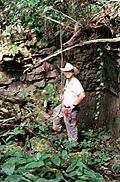
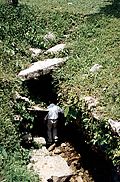
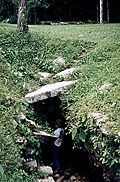
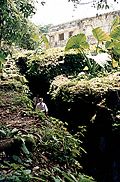
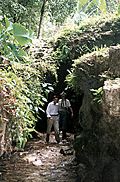
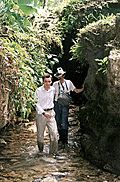
|